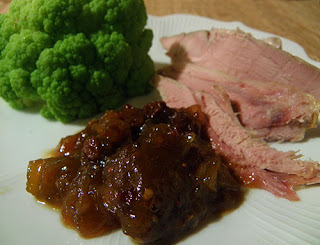 |
| Green Tomato Chutney with Turkey and Cauliflower |
Recipe Adapted from “A Midwest Gardener’s Cookbook”
This post is a contender for most unusual recipe blogged yet
on Seasonal Eating. Move over Candied
Tomatoes, DIY Chen
Pi, and Blue Violet
Tea! Green tomatoes, the recipe’s main ingredient, are not something that
we can buy. But they’re something we end up with when we garden, and in large
amounts if the frost comes early. Sometimes we can pamper late season tomatoes
into ripening by covering them at night and making sure they get full sun
during the day, provided that no cold rains fall. But at some point, we’ll want
to pick all of our green tomatoes and be done with it. I finally threw in the
pampering towel a couple of weeks ago, but the green tomatoes languished in my
refrigerator until last Monday.
 |
| The Active Ingredient |
 |
| Adds Zing to Burgers |
 |
| More Active Ingredients |
Note that peeling green tomatoes is quite a bit harder than
peeling ripe tomatoes, even after you blanch them in boiling water per the
recipe. Many of the green cherry tomatoes couldn’t be peeled at all (skin too
tough and not enough flesh under it), so I just chopped those finely with the
skins on, making sure to use more of the large peeled tomatoes than the
cherries.
 |
| Homemade Holiday Gift |
According to Marian Towne, this chutney is good with curries
and other Indian dishes. It’s also a super accompaniment to turkey and other
meats, and makes a zesty addition to roll-up sandwiches. Any other ideas for
how to use this chutney?
makes 3 half-pints
1½ lbs. green tomatoes
1 cup chopped onion
1 cup raisins
1 cup cider vinegar
¾ cups firmly packed brown sugar
1 tbsp. Worcestershire sauce
½ tbsp. salt
1 tsp. dried mustard
1½ tsp. brown/black mustard seed
¼ tsp. ground ginger
¼ tsp. crushed red pepper
If you’d like to store your chutney long-term rather than in
the refrigerator for immediate consumption, boil 4 half-pint canning jars to
sterilize. Remove with canning jar lifter and set upside-down on tea towel.
Wash lids and cover with hot water in bowl until needed.
Boil a pot of water and cut an X into the skin of each
tomato for easier peeling. Immerse green tomatoes in boiling water for 30
seconds or more to loosen skin. Remove to heatproof bowl with slotted spoon.
When cool enough to handle, peel tomatoes. Chop tomatoes to make about 2 pints.
Place tomatoes into heavy 4-quart saucepan. Add chopped
onion, raisins, cider vinegar, brown sugar, Worcestershire sauce, salt, dried
mustard, mustard seed, ginger, and red pepper if using. Mix well.
Bring to boil, then reduce heat to medium. Simmer uncovered,
stirring periodically, and more frequently as mixture thickens. Simmer about 45
minutes, until well-thickened.
At this point, you may ladle the chutney into jars to be
refrigerated and used within a few weeks, or can the chutney for longer storage
using hot water processing.
Remove from heat and ladle or spoon chutney into half-pint
jars using a wide mouth jam
funnel. Fill jars to ¼ inch from the top. Grab a lid from the hot water
with a lid
lifter and shake off water. Place on top of jar. Screw a ring onto jar. If
you are canning, make sure the ring is barely finger-tight, avoiding
over-tightening as air must escape during hot water processing in order to seal
the jar.
To hot water process:
Remove some water from the pot in which you sterilized the jars, approximately
the total volume of the jars (so water bath won’t overflow—but making sure that
jars will be covered with 2 inches of water). Reheat water to full boil. Remove
from heat while you use the jar
lifter to place each jar into hot water bath.
Return water to gentle boil. You might want to use an
inexpensive digital thermometer to check the water
temperature. Try to keep the temperature between 210 and 212 degrees F. The
chutney will boil and form bubbles in the jars if it gets too hot. Process for 20
minutes, keeping temperature constant by adjusting heat and/or position of pot
on stove. Remove pot from heat.
Use jar
lifter or tongs to remove jars from hot water bath. Set each jar on kitchen
towel. Don’t set directly on any cool or fragile surface. As soon as jars have
cooled enough to handle, tighten rings. An inexpensive ring
tightening gizmo makes this easier.
Cool for several hours or overnight. Lids
must “snap” down to seal. If after cooling you can depress the center of the
lid, it is not sealed. You can either refrigerate that jar and eat it within a
month or remove the ring and lid, wipe the jar top and threads with a damp
paper towel, and reprocess.
 |
| Harmonious Blending of Ingredients |

This sounds great. I made a great tomato chutney last month and love it. I will try your version sometime.
ReplyDeleteHi KT, what did you put into your tomato chutney? I'd love to try a red tomato chutney next year.
ReplyDelete